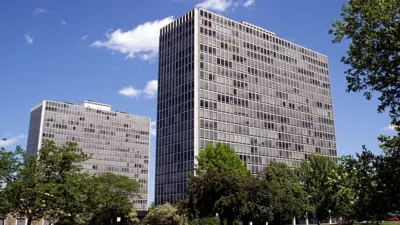A blog post comparing the Athens Charter, written by modernist architects in the 1930s, to traditional urbanism and modern sprawl.

When I read about the historical roots of suburban sprawl, I occasionally see a reference to CIAM (the International Congress of Modern Architecture), a group of modern architects prominent in the early and mid-20th century. I recently read a translation of the CIAM's 1933 Athens Charter; their views certainly tended to promote sprawl, but much of American sprawl would be alien to CIAM's 1930s activists.
CIAM certainly shared the density-phobia that motivated many 20th century policymakers. Paragraphs 9 and 10 of the charter assert that urban density is "too great" and "unhealthy due to insufficient space within the dwelling, absence of usable green spaces and neglected maintenance of the buildings" as well as "the presence of a population with a very low standard of living." It seems to me that CIAM erred in confusing the latter with the former: buildings are poorly maintained not because they are dense or crowded, but because their inhabitants are poor. The absence of "usable green spaces" is not a result of density; in fact, the most dense places (such as Manhattan) often have the most parks and playgrounds. CIAM noted that urban places often had 400-600 inhabitants per acre (para. 9); it is not clear, however, what densities CIAM would have considered healthy.
In addition, CIAM was pro-road. The Athens Charter complains that "inappropriate street dimensions prevent the effective use of mechanized vehicles" (para. 53) and "Street widths are insufficient" (para. 55). But rather than completely ignoring pedestrian needs as did midcentury American policymakers, they did propose to accommodate pedestrians with separate routes (para. 62)—although they failed to explain how these pedestrian routes would be connected to commercial areas. This part of the CIAM agenda does seem to have been implemented in a few places, such as in Radburn, New Jersey (where separate pedestrian pathways complement the street system on some residential blocks)—but even in Radburn, a pedestrian would normally use traditional streets to reach stores.
Unlike pro-sprawl commentators such as Frank Lloyd Wright, CIAM is not obsessed with the large-lot single-family home: indeed, the CIAM Charter barely even mentions the concept. Instead, CIAM focuses on high-rises, asserting that they should be "placed at wide distances apart [to] liberate ground for large open spaces" (para. 29). The Charter's interest in high-rises suggests that they took widespread high-rise construction for granted. However, we now know that CIAM's "Towers In A Park" urbanism does not contribute to walkability, but instead creates vast, sterile open spaces. To see the CIAM Dream in its least atrocious form, one should visit not the typical American suburb but Detroit's Lafayette Park, a neighborhood near downtown with high-rises, garden apartments, and lots of park space in between.
The Athens Charter does mention suburbs, but only in passing, noting that suburbs "have developed without plans" (para. 20) and often lack funds for necessary services (para. 22). I suspect that the notion of suburbs as the dominant form of development would have been alien to the Charter’s drafters.
Like both today’s sprawl lobby and today's new urbanists, CIAM was obsessed with congestion and commuting. They wrote that "[t]he time spent in journeying to work has reached a critical situation" (para. 43) and urged that "Distances between work places and dwelling places should be reduced to a minimum" (para. 46).
But unlike pro-sprawl activists, CIAM did not feign interest in the free market. They complained that "In the absence of planning programs, the uncontrolled growth of cities …caused industry to settle haphazardly" (para. 44). Similarly, they complain about "The irresponsibility of private enterprise" (para. 72) and conclude that "Private interests should be subordinated to the interests of the community" (Para. 94).
In sum, the CIAM Charter supports some of the ingredients of modern sprawl (such as wide roads and lowered densities)—but other parts of sprawl (such as the dominance of suburbia) seem alien to its agenda.

Analysis: Cybertruck Fatality Rate Far Exceeds That of Ford Pinto
The Tesla Cybertruck was recalled seven times last year.

National Parks Layoffs Will Cause Communities to Lose Billions
Thousands of essential park workers were laid off this week, just before the busy spring break season.

Retro-silient?: America’s First “Eco-burb,” The Woodlands Turns 50
A master-planned community north of Houston offers lessons on green infrastructure and resilient design, but falls short of its founder’s lofty affordability and walkability goals.

Test News Post 1
This is a summary

Analysis: Cybertruck Fatality Rate Far Exceeds That of Ford Pinto
The Tesla Cybertruck was recalled seven times last year.

Test News Headline 46
Test for the image on the front page.
Urban Design for Planners 1: Software Tools
This six-course series explores essential urban design concepts using open source software and equips planners with the tools they need to participate fully in the urban design process.
Planning for Universal Design
Learn the tools for implementing Universal Design in planning regulations.
EMC Planning Group, Inc.
Planetizen
Planetizen
Mpact (formerly Rail~Volution)
Great Falls Development Authority, Inc.
HUDs Office of Policy Development and Research
NYU Wagner Graduate School of Public Service





























